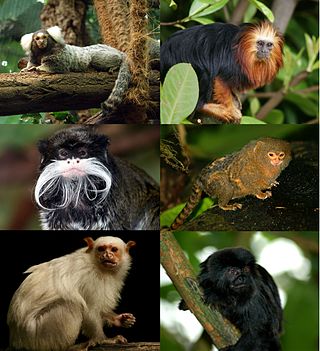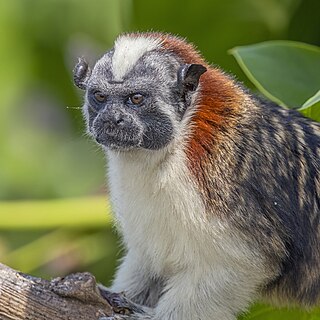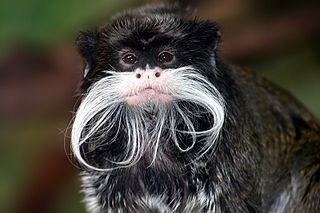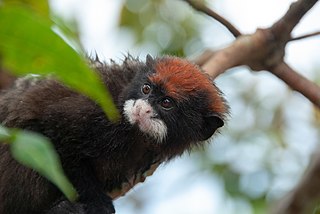
The Callitrichidae are a family of New World monkeys, including marmosets, tamarins, and lion tamarins. At times, this group of animals has been regarded as a subfamily, called the Callitrichinae, of the family Cebidae.

The Goeldi's marmoset or Goeldi's monkey is a small, South American New World monkey that lives in the upper Amazon basin region of Bolivia, Brazil, Colombia, and Peru. It is the only species classified in the genus Callimico, and the monkeys are sometimes referred to as "callimicos". The species takes its name from its discoverer, Swiss-Brazilian naturalist Emil August Goeldi.

Night monkeys, also known as owl monkeys or douroucoulis, are nocturnal New World monkeys of the genus Aotus, the only member of the family Aotidae. The genus comprises eleven species which are found across Panama and much of South America in primary and secondary forests, tropical rainforests and cloud forests up to 2,400 metres (7,900 ft). Night monkeys have large eyes which improve their vision at night, while their ears are mostly hidden, giving them their name Aotus, meaning "earless".

Howler monkeys are the most widespread primate genus in the Neotropics and are among the largest of the platyrrhines along with the muriquis (Brachyteles), the spider monkeys (Ateles) and woolly monkeys (Lagotrix). The monkeys are native to South and Central American forests. They are famous for their loud howls, which can be heard up to three miles away through dense rain forest. Fifteen species are recognized. Previously classified in the family Cebidae, they are now placed in the family Atelidae. They are primarily folivores but also significant frugivores, acting as seed dispersal agents through their digestive system and their locomotion. Threats include human predation, habitat destruction, illegal wildlife trade, and capture for pets or zoo animals.

The golden lion tamarin, also known as the golden marmoset, is a small New World monkey of the family Callitrichidae. Endemic to the Atlantic coastal forests of Brazil, the golden lion tamarin is an endangered species. The range for wild individuals is spread across four places along southeastern Brazil, with a recent census estimating 3,200 individuals left in the wild and a captive population maintaining about 490 individuals among 150 zoos.

The pied tamarin, sometimes referred to as the Brazilian bare-faced tamarin, is a critically endangered species of primate found in a restricted area of the Brazilian Amazon Rainforest. It was named the mascot of Manaus, Brazil in 2005. The species is endangered due to the increasing size of the city of Manaus which is encroaching on their native habitat.

Geoffroy's tamarin, also known as the Panamanian, red-crested or rufous-naped tamarin, is a tamarin, a type of small monkey, found in Panama and Colombia. It is predominantly black and white, with a reddish nape. Diurnal, Geoffroy's tamarin spends most of its time in trees, but does come down to the ground occasionally. It lives in groups that most often number between three and five individuals, and generally include one or more adults of each sex. It eats a variety of foods, including insects, plant exudates, fruits and other plant parts. Insects and fruits account for the majority of its diet, but exudates are also important. But since its teeth are not adapted for gouging trees to get to the sap, it can only eat exudates when they are easily available.

Pygmy marmosets are two species of small New World monkeys in the genus Cebuella. They are native to rainforests of the western Amazon Basin in South America. These primates are notable for being the smallest monkeys in the world, at just over 100 g (3.5 oz). They are generally found in evergreen and river-edge forests and are gum-feeding specialists, or gummivores.

The tamarins are squirrel-sized New World monkeys from the family Callitrichidae in the genus Saguinus. They are the first offshoot in the Callitrichidae tree, and therefore are the sister group of a clade formed by the lion tamarins, Goeldi's monkeys and marmosets.

The cotton-top tamarin is a small New World monkey weighing less than 0.5 kg (1.1 lb). This New World monkey can live up to 24 years, but most of them die by 13 years. One of the smallest primates, the cotton-top tamarin is easily recognized by the long, white sagittal crest extending from its forehead to its shoulders. The species is found in tropical forest edges and secondary forests in northwestern Colombia, where it is arboreal and diurnal. Its diet includes insects and plant exudates, and it is an important seed disperser in the tropical ecosystem.

The emperor tamarin is a species of tamarin monkey allegedly named for its resemblance to the German emperor Wilhelm II. It lives in the north Brazilian states of Acre and Amazonas and the southwest Amazon Basin, in east Peru, north Bolivia.

The golden-handed tamarin, also known as the red-handed tamarin or Midas tamarin, is a New World monkey belonging to the family Callitrichidae.

The black tamarin or western black-handed tamarin is a species of tamarin endemic to Brazil.

The brown-mantled tamarin, also known as Spix's saddle-back tamarin, is a species of saddle-back tamarin. This New World monkey is found in the Southern American countries of Bolivia, Brazil and Peru. This omnivorous member of the Callitrichidae family is usually found in smaller groups ranging between 4 and 15 individuals. This species communicates vocally and largely rely their olfactory system. The brown-mantled tamarin is considered as a species of Least Concern by the International Union for Conservation of Nature, despite a decreasing population and being threatened by poaching, habitat loss and capture for the illegal pet trade.

The white-footed tamarin is a tamarin species endemic to Colombia. It is a silvery brown colour with pale streaks and russet underparts, and is very similar in appearance to the cotton-top tamarin, from which it is separated by the Atrato River. It is thought that the two species diverged during the Pleistocene, at a time when a sea occupied the area between their present ranges. This tamarin is an arboreal species, living in small family groups in the canopy. Females give birth to one to three young after a gestation period of about 140 days. This species has a relatively small range and is under threat from destruction and fragmentation of the forest in which it lives and the International Union for Conservation of Nature has assessed its conservation status as "vulnerable".

The golden-mantled tamarin is a tamarin species from South America. It is found in Ecuador and Peru, specifically in the upper Amazon (lowland), east of the Andes in Ecuador, and Northeast Peru; between the Rio Curaray and Rio Napo in Peru.
Paul Garber is a primatologist and the author and editor of several books and articles about primates. He is a professor at the University of Illinois. He is editor of the American Journal of Primatology and director of research and education at La Suerte Biological Field School in Costa Rica. Books he has authored or edited include New Perspectives in the Study of Mesoamerican Primates: Distribution, Ecology, Behavior, and Conservation , On the Move: How and Why Animals Travel in Groups, Adaptive Radiations of Neotropical Primates. and South American Primates: Comparative Perspectives in the Study of Behavior, Ecology, and Conservation In 2014, he co-edited two books on howler monkeys. He has also studied interrelationships between the moustached tamarin and the saddleback tamarin.

The bearded emperor tamarin is one of the two subspecies of the emperor tamarin. It is mostly found in the tropical forests of southwestern Brazil and eastern Peru. This omnivorous member of the Callitrichidae family is usually found in groups of 4 and shares social relations with other callitrichids. They communicate vocally, as well as with olfactory signals. Males tend to be primary caregivers for their young. It is considered as a species of Least Concern by the IUCN, despite threats from increased habitat loss.

The red-capped tamarin, is subspecies of moustached tamarin from South America. They are found in Brazil, on the eastern margin of the Tefé and Coari rivers. Previously recognised as a separate species, Saguinus pilatus, the red-capped tamarin was demoted to subspecies status by a taxonomic review by Rylands et al., (2016).

Geoffroy's saddle-back tamarin is a species of saddle-back tamarin, a type of small monkey from South America. Geoffroy's saddle-back tamarin was formerly considered to be a subspecies of the brown-mantled tamarin, L. fuscicollis. It lives in Loreto, Peru.




















